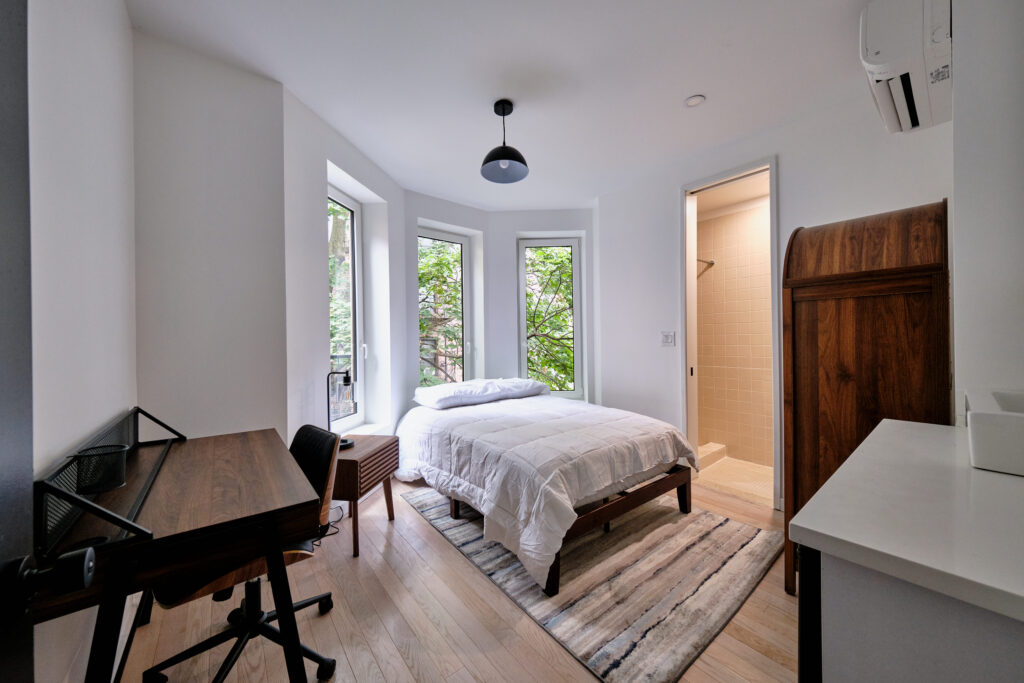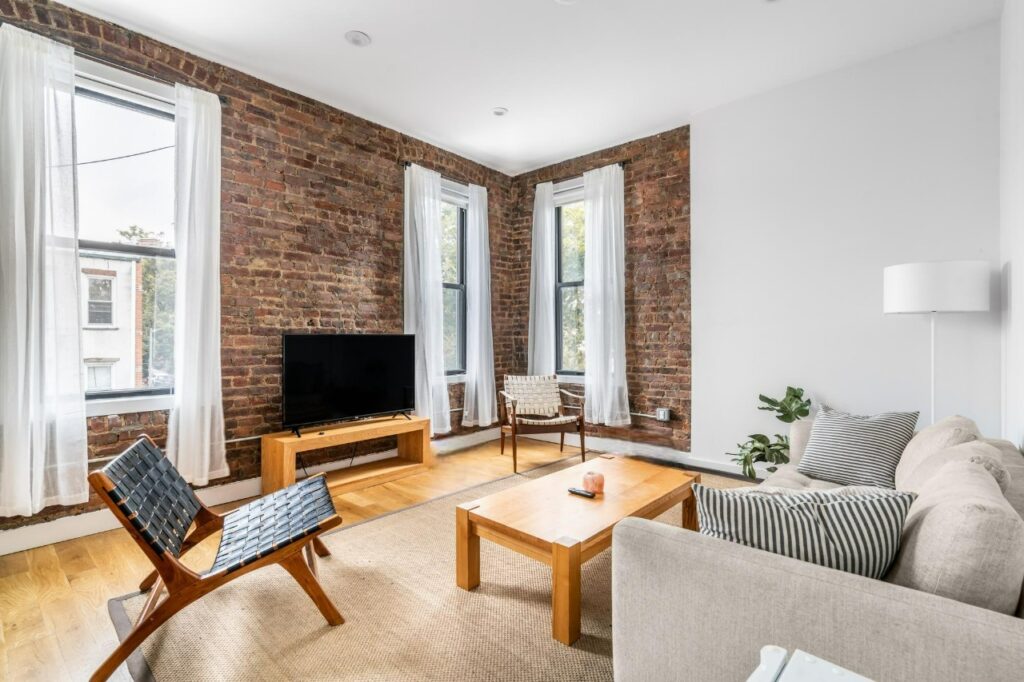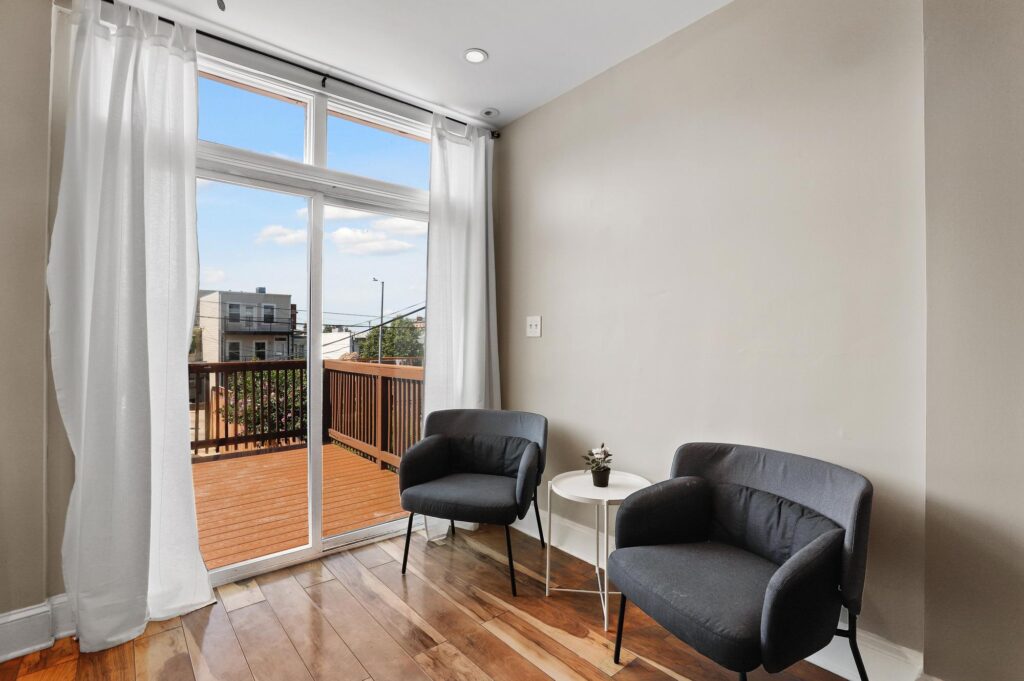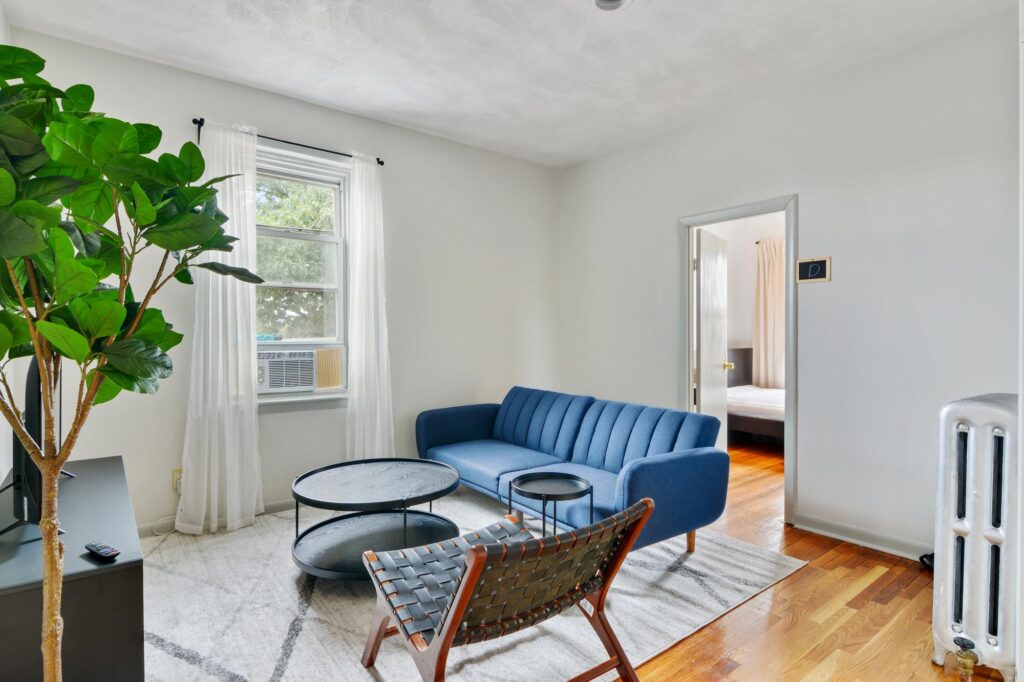Estimated reading time: 10 minutes

When you’re searching for affordable housing, the sheer number of rental options can feel overwhelming. Roomshare, co-living, shared apartments, sublets – what do all these terms actually mean, and how do you know which one fits your situation? Understanding these different types of room rentals can save you time, money, and potentially a lot of headaches.
Each type of room rental comes with its own set of rules, expectations, and trade-offs. Some offer more flexibility but less stability, while others provide community but require compromise. Here’s your complete breakdown of what’s actually available when you’re looking for a room to rent.
Enjoy a hassle-free, high-end rental experience for stays of one month or longer in major US cities.

Fully-furnished rooms and apartments with flexible lease. Apply today and move in tomorrow.
Traditional Roommate Situations
What It Is
This is the classic setup where you and one or more people jointly rent an entire apartment or house. Everyone’s name goes on the lease, you split all costs equally (or negotiate different arrangements), and you’re all equally responsible for rent, utilities, and maintaining the space.
How It Works
You’ll typically find roommates through apps or online platforms, then search for apartments together. Each person usually has their own bedroom while sharing common areas like the kitchen, living room, and potentially bathrooms. Splitting expenses with roommates becomes a collaborative effort where you decide together how to handle everything from rent to groceries.
Pros
- Complete control over your living environment and house rules
- Ability to choose both your living space and your housemates
- Often the most cost-effective option for quality housing
- Flexibility to personalize and decorate shared spaces
- Potential for close friendships and long-term living arrangements
Cons
- Joint liability means you could be stuck covering rent if roommates leave
- Requires coordination for everything from utilities setup to furniture purchases
- More responsibility for maintenance, repairs, and landlord communication
- Potential for serious conflicts with no professional mediation available
Best For
People who want maximum control over their living situation and don’t mind taking on the responsibilities of traditional renting. Works well if you already know potential roommates or have time to carefully vet people before committing to a lease together.
Co-Living Spaces
What It Is
Purpose-built or professionally managed properties designed specifically for shared living. These spaces often include premium amenities, community programming, and professional management services. Think of it as shared living with hotel-like services.
How It Works
Co-living companies handle tenant screening, match compatible residents, and manage the property. You typically get a private bedroom (sometimes with private bathroom) while sharing high-end common areas. Many locations include cleaning services, utilities, and even community events in the monthly fee.
Pros
- Professional management handles maintenance, conflicts, and administrative tasks
- High-quality amenities like gyms, rooftop spaces, co-working areas
- Built-in community with organized social events and networking opportunities
- All-inclusive pricing simplifies budgeting and bill management
- Often furnished apartments that are move-in ready
Cons
- Higher cost than traditional roommate arrangements
- Less control over house rules and living environment
- May feel institutional rather than homey
- Limited ability to personalize shared spaces
- Potential for high turnover as people treat it more like extended hotel stays
Best For
Young professionals who value convenience and community over cost savings. Ideal if you’re new to a city, work long hours, or want amenities you couldn’t afford alone.
Shared Apartments (Room in Someone’s Lease)
What It Is
You rent a bedroom in an apartment where someone else is the primary leaseholder. Your name might not be on the main lease, though you should still have some form of written agreement. This is different from subletting because it’s typically a longer-term arrangement.
How It Works
The primary tenant finds additional roommates to help cover costs and share the space. You’ll typically pay the primary tenant directly, who then handles rent and utilities with the landlord. Calculating your fair share becomes important since you want to ensure you’re not overpaying for your portion of the space.
Pros
- Easier move-in process since lease arrangements already exist
- Less financial liability if other roommates have problems
- Primary tenant often handles utility setup and maintenance coordination
- Can be more flexible than traditional leases
Cons
- Limited legal protection since you’re not the primary tenant
- Less control over household decisions and rules
- Potential for exploitation if primary tenant overcharges
- Could be asked to leave more easily than with your own lease
Best For
People who need housing quickly or want less responsibility for lease management. Good option if you find a trustworthy primary tenant with a stable situation.
Subletting Arrangements
What It Is
Subletting means temporarily taking over someone else’s lease obligation while they’re away. The original tenant remains responsible to the landlord, but you pay them and live in their space for a predetermined period.
How It Works
Someone needs to leave their apartment temporarily (study abroad, internship, family emergency) and finds a subletter to cover rent while they’re gone. You’ll typically have a written agreement with the original tenant, though the landlord may or may not know about the arrangement.
Pros
- Usually shorter-term commitments perfect for temporary housing needs
- Often cheaper than hotels for extended stays
- May come furnished with the original tenant’s belongings
- Can be found quickly for immediate housing needs
Cons
- Limited legal protection and unclear tenant rights
- Original tenant could return unexpectedly or end arrangement early
- Potential legal issues if landlord doesn’t approve subletting
- Usually can’t personalize the space or make changes
- Subletting vs. subleasing differences can be confusing legally
Best For
People with temporary housing needs like students, interns, or those between permanent housing arrangements. Also good for summer housing or short-term work assignments.
Rooms from Private Owners
What It Is
Individual property owners who rent out rooms in their own homes or investment properties. This could be a spare bedroom in someone’s primary residence or a room in a property they specifically purchased for rental income.
How It Works
You’ll typically deal directly with the homeowner rather than a property management company. Arrangements can range from very informal (month-to-month handshake deals) to formal lease agreements. Finding these opportunities often requires searching multiple platforms and being prepared to move quickly.
Pros
- Often more affordable than managed properties
- Direct relationship with decision-maker for repairs and issues
- May offer more flexibility in lease terms and house rules
- Potential for personal mentorship or friendship with older homeowners
- Sometimes includes additional perks like home-cooked meals or guidance about the area
Cons
- Inconsistent standards and professionalism
- Limited legal recourse if problems arise
- May lack privacy if living in owner’s primary residence
- Potential for uncomfortable personal dynamics
- Less predictable availability and pricing
Best For
People comfortable with less formal arrangements and those who value personal connections over professional management. Can work well for students or young professionals who appreciate guidance from experienced adults.
Extended Stay Options
What It Is
Hotel-like accommodations designed for stays longer than typical vacations but shorter than traditional leases. These can range from extended stay hotels to furnished rentals specifically marketed to temporary residents.
How It Works
You’ll typically pay weekly or monthly rates for a private room (usually with private bathroom) and may have access to shared common areas, kitchens, and amenities. Services often include cleaning, utilities, and sometimes meals.
Pros
- No lease commitment or long-term financial obligations
- All-inclusive pricing with utilities and often furniture included
- Professional management and maintenance services
- Flexibility to leave with short notice
- Good option while apartment hunting or during transitions
Cons
- Much higher cost per month than traditional rentals
- Limited ability to establish a real “home” feeling
- May have restrictions on guests, cooking, or personalization
- Often located in commercial areas rather than residential neighborhoods
- Lack of community building or long-term relationships
Best For
Business travelers, people in career transitions, or those who need temporary housing while searching for permanent arrangements. Also suitable for travel nurses or consultants on short-term assignments.
How to Choose What’s Right for You
Consider Your Timeline
If you need housing for less than six months, subletting or extended stay options might make sense. For longer-term needs, traditional roommate arrangements or co-living spaces offer better value and stability.
Evaluate Your Budget
Calculate how much rent you can afford before comparing options. Remember that cheaper monthly rent might come with hidden costs like utilities, furniture, or higher security deposits.
Think About Lifestyle Preferences
Do you want to come home to social interaction or peaceful solitude? Are you comfortable sharing kitchen space and coordinating cleaning schedules? Your answers will help determine whether co-living, traditional roommates, or private arrangements suit you better.
Assess Your Housing Experience
First-time renters might benefit from the guidance of co-living spaces or experienced private landlords, while those with rental experience can handle the responsibilities of traditional roommate arrangements.
Location Priorities
Some options work better in certain cities. NYC room hunting requires different strategies than finding rooms in Boston, and what’s available varies significantly between markets.
Red Flags to Watch Out For
Financial Warning Signs
Be wary of arrangements requiring large upfront payments, cash-only transactions, or prices significantly below market rate. Avoiding rental scams requires skepticism about deals that seem too good to be true.
Legal Concerns
Ensure any arrangement includes written agreements, even if informal. Understand your rights and responsibilities, especially in subletting situations where legal protections may be limited.
Safety Issues
Meet landlords or primary tenants in person before committing, check references when possible, and trust your instincts about people and situations that feel off.
Making Your Decision
Questions to Ask Yourself
- How important is cost versus convenience in your situation?
- Do you want more control or less responsibility in your housing arrangement?
- Are you looking for community and social interaction or privacy and independence?
- How much time can you dedicate to managing housing logistics?
- What’s your backup plan if the arrangement doesn’t work out?
Testing the Waters
Consider shorter-term arrangements initially to test different types of living situations before committing to longer leases. You might discover you love co-living community aspects or prefer the independence of traditional roommate situations.
Getting Started
Once you know what type of room rental works for your situation, prepare your application materials and start your search with realistic expectations about timing and competition in your market.
The key to successful room rental hunting is understanding that each option serves different needs and life stages. A co-living space might be perfect when you’re new to a city but feel restrictive once you’re established. Traditional roommate arrangements offer more control but require more effort to coordinate.
Take time to honestly assess your priorities, timeline, and comfort level with different arrangements. Moving to a new place is stressful enough without choosing the wrong type of housing situation for your needs. With the right match between your situation and rental type, you can find affordable housing that actually improves your quality of life rather than just solving your budget problems.




